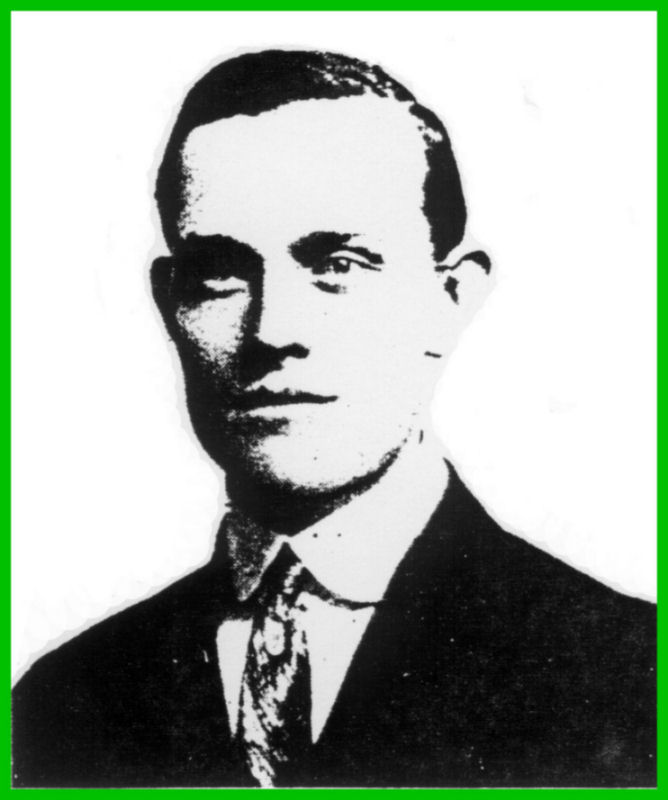

Edward Franklin Flannery was born in a mining camp at Grape Creek, Illinois on 16th January 1893; the son of Seán and Carrie Belle Flannery. Seán was a member of the Knights of Labor, a union activist and a dynamiter in the coal mines of Illinois. Seán’s parents, Thomas and Anne (née Neenan) Flannery, had come to America from County Mayo in 1864. They first settled in Pittsburgh and then relocated to LaSalle, Illinois. These were the grandparents of Ed Flannery.
By 1906 Ed had completed six grades in school and the family considered him ready to work with his father in the Economy Mine at Danville near the Indiana line. By his teen years he’d had enough of the harsh, dangerous work and announced his decision to the family. According to a later account he wrote: “I looked back on my experience in the mines as an asset. It was killing work I’ve always been proud of but as few others did, I left while I could still walk out and I never looked back.”
While working as a telegrapher on the railroads Ed began reading for long hours and educating himself. By 1912 at age 19, he was writing articles for the Commercial News, a daily newspaper in Danville and had attracted the attention of their editors. Those supervisors began an “on the job training program” to forge his writing skills. Those educational efforts paid off after a short time and he soon moved into police reporting and then came further advancements with larger newspapers across the Middle West.
By 1921 he’d served in the Army (147th Division, HQ Company) and returned to reporting when he was invited to Florida to work as a staff reporter for the Miami Herald. Even in that era the publication was highly respected for its news coverage of events in the Caribbean and South America. Miami had been selected as the main hub for air travel to distant lands and Pan American Airways operated an international seaplane base from Biscayne Bay.
In 1922 Ed’s journalistic career reached its zenith when the Herald nominated him for a Pulitzer Prize in reporting. His full-page story detailed the tragic loss of a seaplane during a crash-landing at sea. All passengers aboard were killed and only the pilot survived. Ed’s interview of the pilot captured dramatic efforts to save those aboard the ditched plane. Then it chronicled the hopeless hours awaiting rescue in rough seas as passengers slipped beneath the waves.
The Pulitzer that year was awarded to Kirke L. Simpson, a reporter for the Associated Press. He had written a lengthy and moving account on the burial of the US Unknown Soldier of World War I. The story had attracted great attention and appeared in newspapers world-wide.
Shortly after recognition of his writing skills, Ed moved on to a new career with the developer of Miami Beach, Carl Fisher. He was named publicity director for the Roney Plaza hotel, the premier resort in that tourist mecca.
By 1928 wanderlust overcome him and he accepted the post of editor with a business magazine in Fort Worth, Texas. It was his last venture into the world of business and industry. He soon returned to the more familiar and appealing role of news reporter.
Ed Flannery was married twice and had four children. His first wife died in 1919 and he remarried in 1921. Robert Flannery of West Palm Beach, Florida is the only surviving child and is a member of the Flannery Clan. “My father died when I was a small child,” he said. “I never knew him but spoke to many who had worked with him in South Florida. He had touched many lives in his passage. A few spoke with affection and others considered him talented but cold and overly ambitious. I have always believed he was a genius in many ways but his health was always marginal. Years in the coal mines as a child had damaged his lungs and pneumonia killed him at age 41. He had just accepted an editorial post with the Atlanta Constitution and was in route there when he died in Ogden, Utah.”
In tabulating a family tree for the Flannery Clan and listing potential members, four generations of Ed Flannery’s offspring were tabulated. The total came to 41 with several more on the way. These family members range across the Midwest and into the Southern and Western states.
Edward died in Ogden, Utah, on 18th December 1934, and was buried in Oak Hill Cemetery, Danville. Illinois.
[his portrait is illustrated above; courtesy of his son, Bob Flannery]